How to Conduct an Effective Twitter Audit for Performance Optimization?
Conduct a thorough Twitter audit to assess strategy effectiveness. Analyze followers and engagement metrics to refine your social media approach.


While nowadays Twitter (now known as X) does not receive as much attention as other social media platforms, like Instagram or TikTok, for example, it still remains the number-one channel for news and rapid spread of important information.
So, if you’re in a business line such as the media industry, you certainly understand the importance of having a Twitter presence.
For your Twitter account to break through the noise made by the gigantic wave of news out there, you’ll need a consolidated social media strategy.
And to evaluate your results and strategy, you have to run a social media audit.
To learn how to conduct an in-depth, insightful Twitter audit, dive into our guide below.
Key takeaways
-
A Twitter audit involves reviewing your profile setup, analyzing follower demographics, evaluating content performance, checking posting frequency and engagement, identifying top formats, and refining your strategy based on insights.
-
A successful Twitter audit hinges on monitoring engagement, impressions, follower growth, top tweets, best posting times, and best performing content pillars to uncover what truly drives performance.
-
Using specialized Twitter audit tools streamlines the process, giving you accurate data, actionable insights, and a clearer view of your account’s overall health.
What is a Twitter audit?
A Twitter audit consists of the analysis of an account’s performance to establish if its current content and tactics leveraged are effective for achieving the business goals a brand has set for its Twitter marketing strategy. It implies digging into followers’ data, engagement metrics, and impressions to discover what works and what does not.
For a Twitter audit report to enable you to discover the best optimization strategies, you can also integrate competitive insights and industry benchmarks to add context to your data.
Why run a Twitter audit?
A thorough Twitter account audit helps you see how your brand is performing, determine if you’re moving in the right direction, and uncover your weaknesses.
By conducting a Twitter audit, you can gain valuable insights into how to optimize your strategy and drive better results. Among the main benefits of running a TikTok audit are the following:
- it highlights if your current content strategy is effective in getting the attention of your target audience;
- it helps you understand your followers’ needs and pain points;
- it emphasizes what are your best formats or content pillars and campaigns.
How to do a Twitter audit?
Performing a Twitter audit may not be your favorite task as a marketer, as it implies digging into a lot of data that can, at times, be pretty overwhelming.
However, if you want to discover how to get better results from your Twitter marketing efforts, a Twitter audit is your best option.
So, if you want to learn how to perform a Twitter analysis or how to improve your Twitter reporting process, just follow the steps below, and you're set for an awesome Twitter audit.
Make sure your profile is completed
First, you should start exactly where most of your audience does, by looking at your Twitter profile. Your brand logo, header photo and profile photo should be aligned.
Also make sure you keep in mind the required dimensions for each image. Your profile photo should be 400 x 400 pixels, while your header should have 1500 x 500 pixels.
Make sure your Twitter bio is not just an empty space. Use those 160 characters responsibly to attract the right people from the start.
And yes, people really do read social media bios. At least I do. Your bio should explain what your brand’s about and how it can help prospective clients.
If you have some pinned Tweets check to see what they are about, and remove those which are no longer relevant. Maybe you have more recent posts about your latest accomplishments or updates.
Dive into your posts' metrics
The next thing you should look at are your tweets. The tone of voice you use and the type of content you post can tell a lot about your brand.
One of your main interests is to develop your own trademark when it comes to writing. Since the length of posts is quite limited (4000 characters for Twitter Blue subscribers but only 280 characters for non-paying users), make sure you use the right words to deliver your message.
Then assess the type of content you use. There is a wide range of post types you can choose from. You can test them all and then analyze which ones are performing better to know where your focus should be.
Better yet, check which post type performs best on Twitter using Socialinsider. To do that, you need to connect your Twitter account and head to your Twitter analytics dashboard.
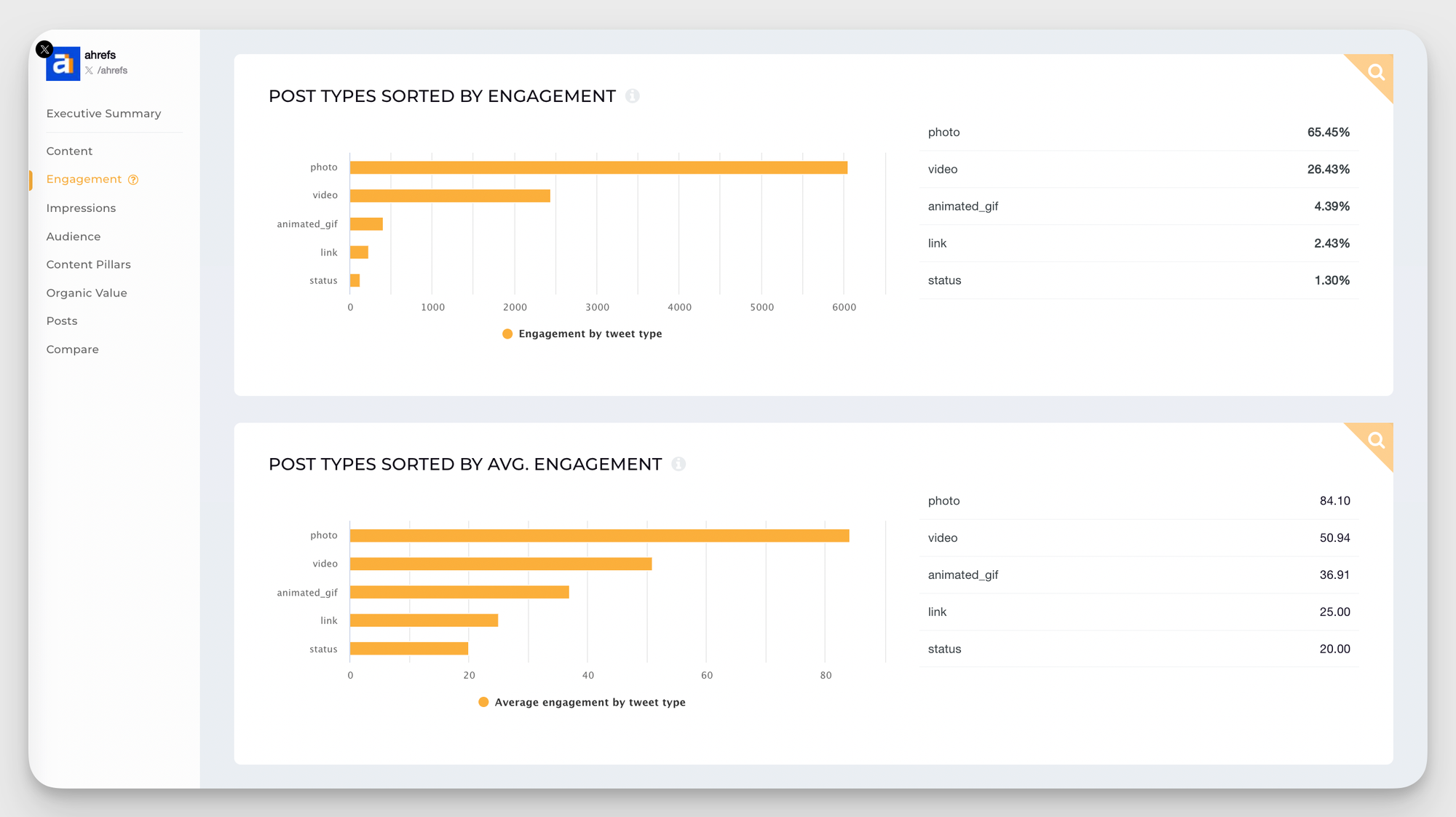
Once you get there, you'll quickly have access to a wide variety of metrics - from the most important ones, like engagement, impressions andfollower growth, to more in-depth ones, such as best-performing content pillars, top tweets and many more.
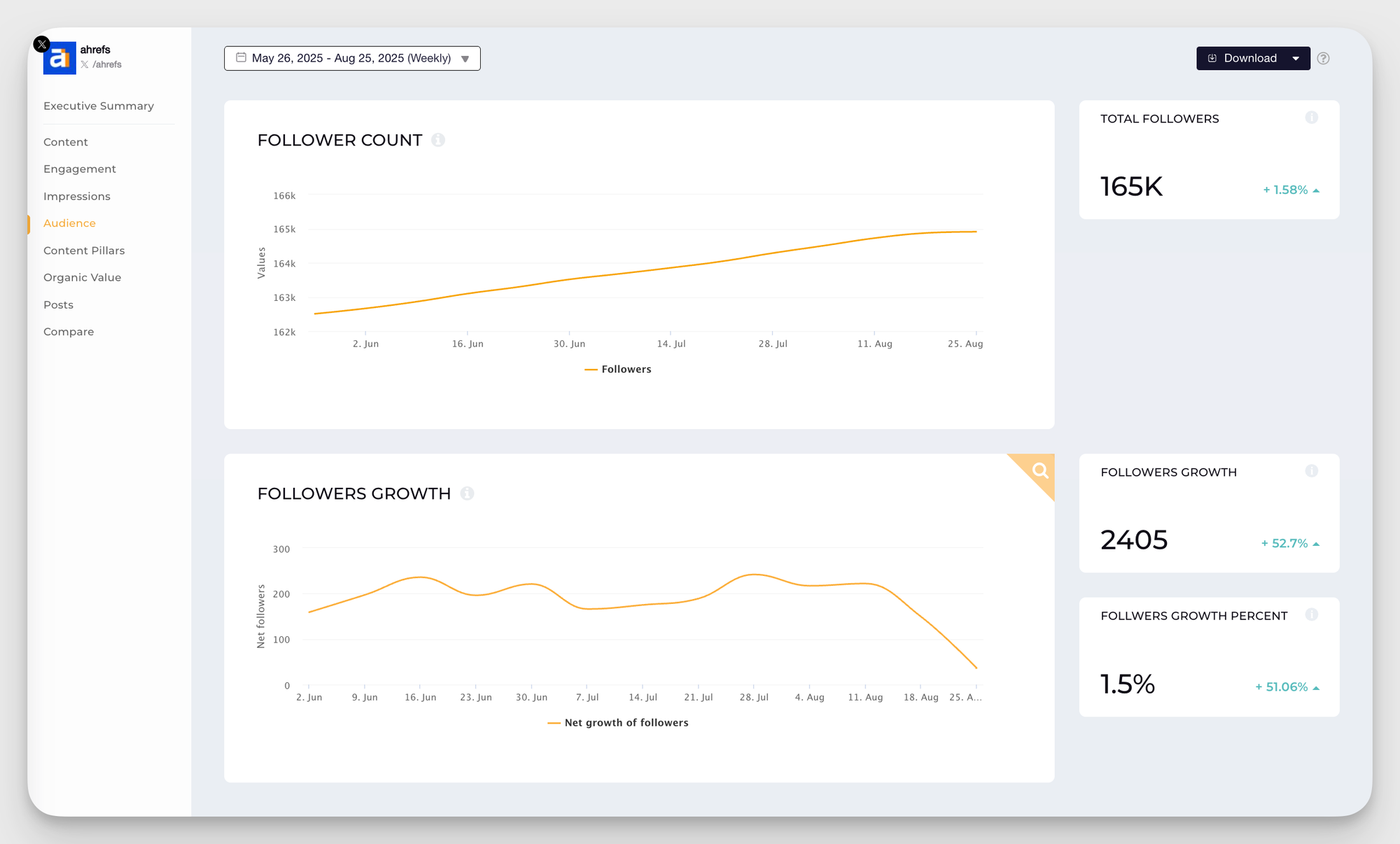
To dig deeper into your posts' performance, navigate to the Posts section. Here, you can play around with the sorting options available, which will organize your list by the metric you choose.
Analyze what the best posting frequency and time are for your brand
As soon as you figure out what type of posts perform better for your brand, you should think about the frequency of posting.
We all know that on other social media platforms the information flow is slower and you do not even need to post on a daily basis. However, with Twitter, it’s a different story.
The frequency of posting on this channel is several tweets per day, ranging from 5 to 10 tweets or even more.
Depending on your brand’s policy and the industry you activate in, your number of daily posts can vary.
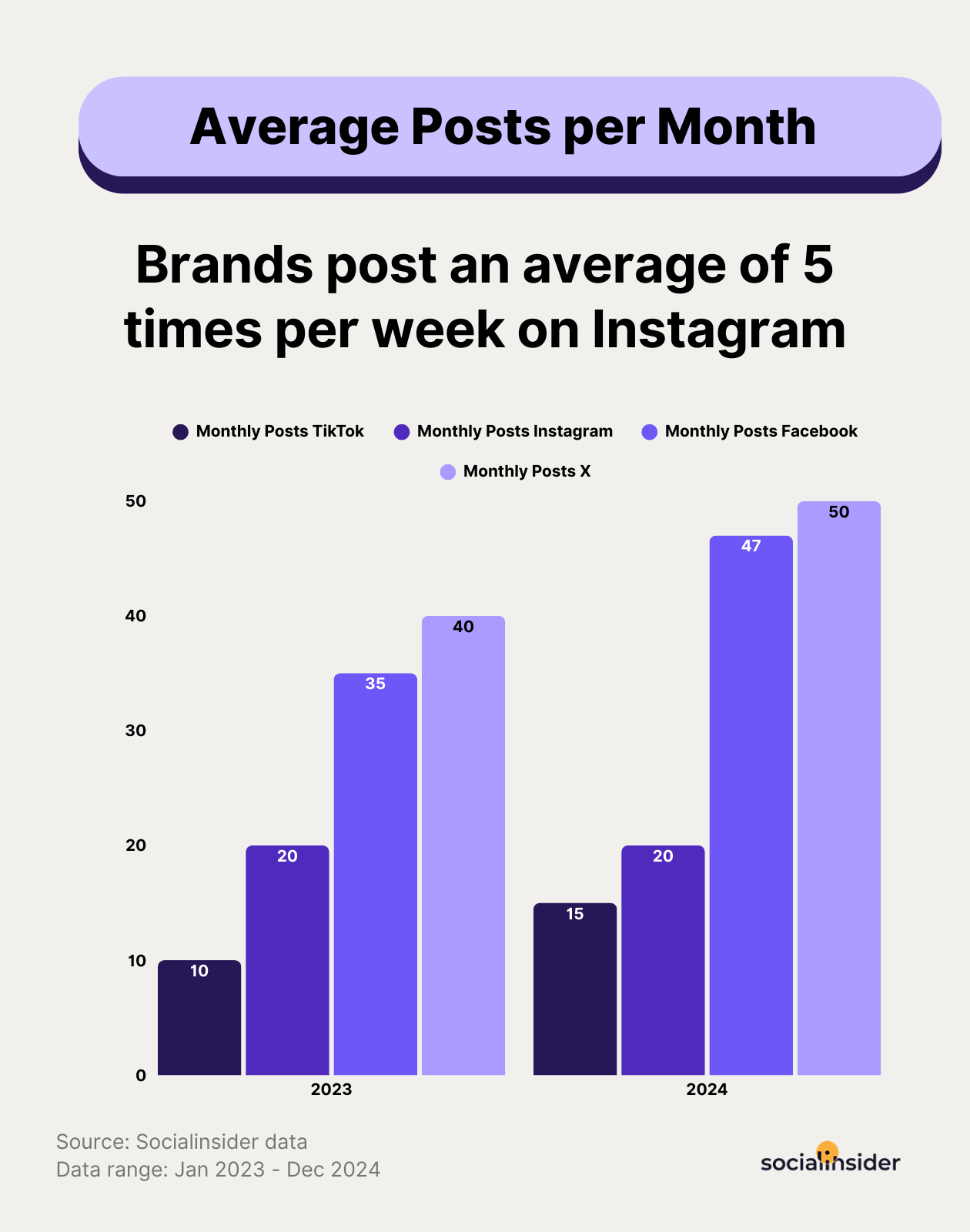
And equally important is to identify your best time to post, since you want to maximize visibility. For this, Socialinsider is a quick helper.
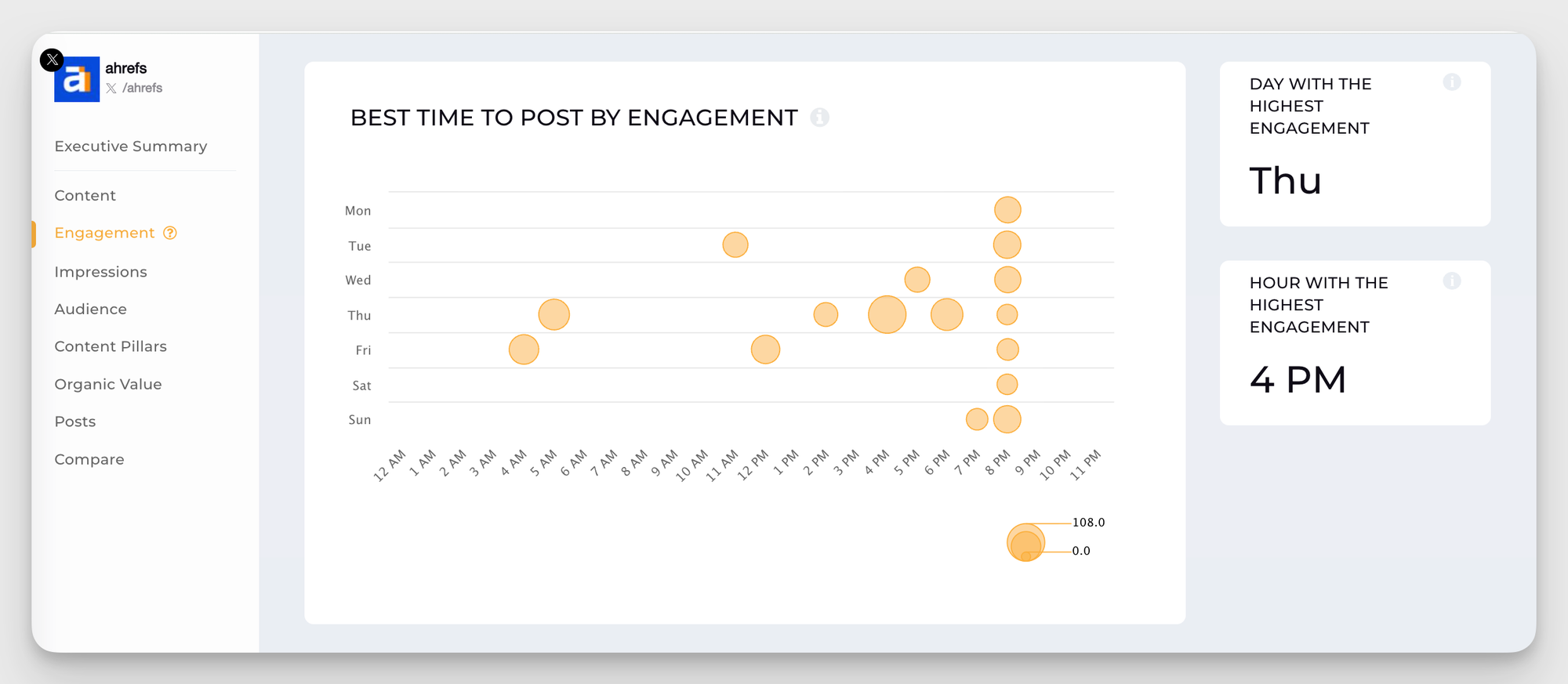
Gain insights about your audience
Finding out your audience's preferences, interests, and opinions is essential for effective social media best practices.
For an improved strategy, you need to learn more about your followers, so that you could understand how to transform them into loyal customers and even brand advocates.
How to do a Twitter followers audit
Fake Twitter followers are a thing and many businesses try to keep themselves away from them.
Unfortunately, these fake followers are inevitable since you cannot always check all the details.
If you are trying to separate fake followers on Twitter from the real ones, here are a few things you should check:
- Profile picture - A bot or a fake Twitter account avoids choosing a profile picture or they may use a generic one, probably a picture stolen from Google.
- Bio - If the Twitter bio has no data, then something must be fishy. Users generally describe themselves in their bio, writing about their jobs and passions. A fake twitter account or a bot may not complete the bio in detail.
- Twitter handles - If the account name does not match the Twitter handle, then you know that is not a real person.
- Engagement level - Even if you may see bigger numbers, fake followers do not actually add value to your business’ account.
- Unrealistic follower count - An unrealistic number of followers is also something that should make you become suspicious about the legitimacy of a Twitter account.
- Duplicate or generic tweets - Generic tweets or those which seem to be duplicates in the different conversations, it is clear that the Twitter account you’re looking at is not a real one.
Alternatively, you can use a tool like followerAudit to check how many of your brand's Twitter followers are legitimate and how many are fake:
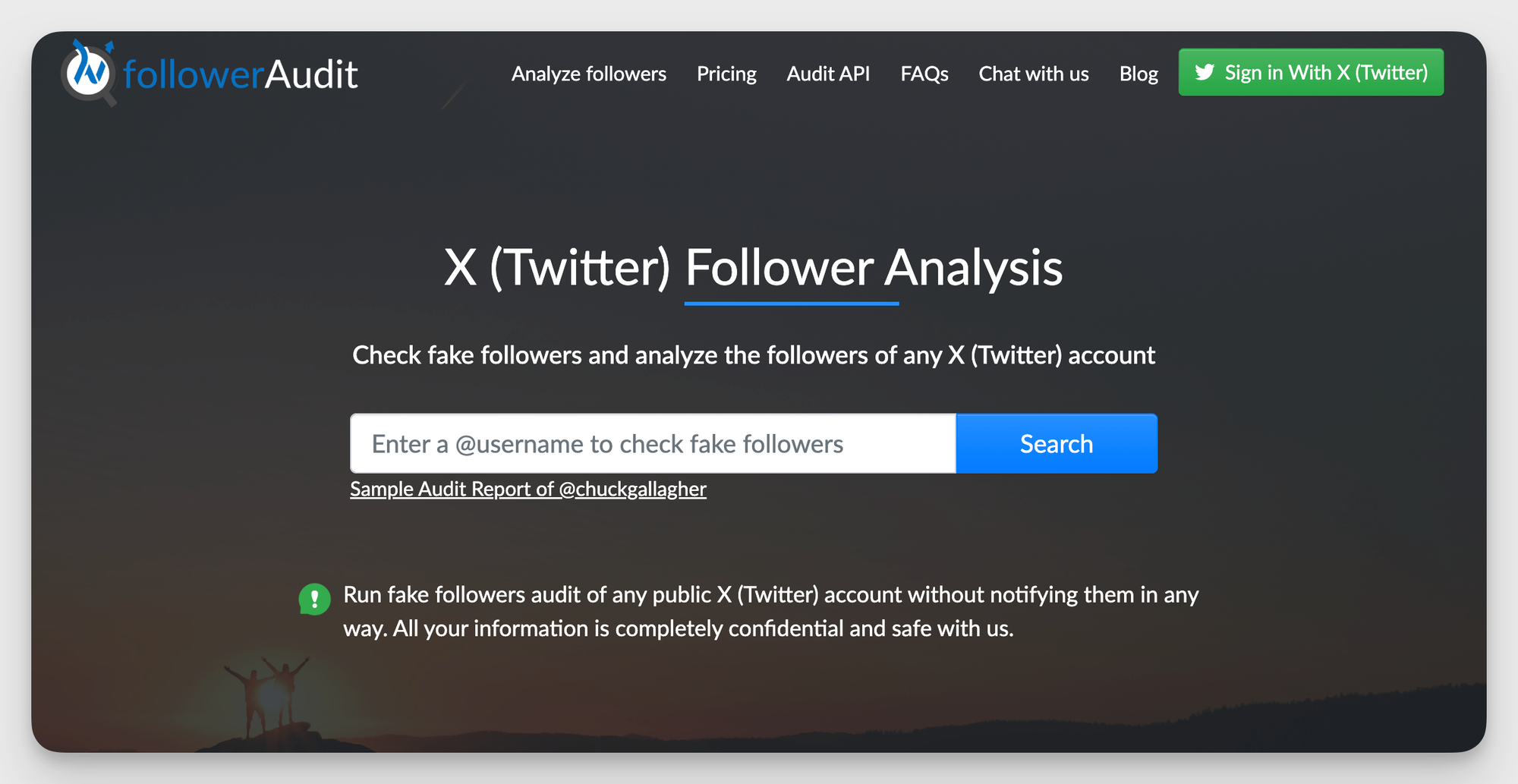
Come up with strategy optimization directions
After you have performed your Twitter audit, you need to jot down some conclusions.
What are your most engaging content pillars? How does your brand stack up against industry benchmarks? What’s your next move?
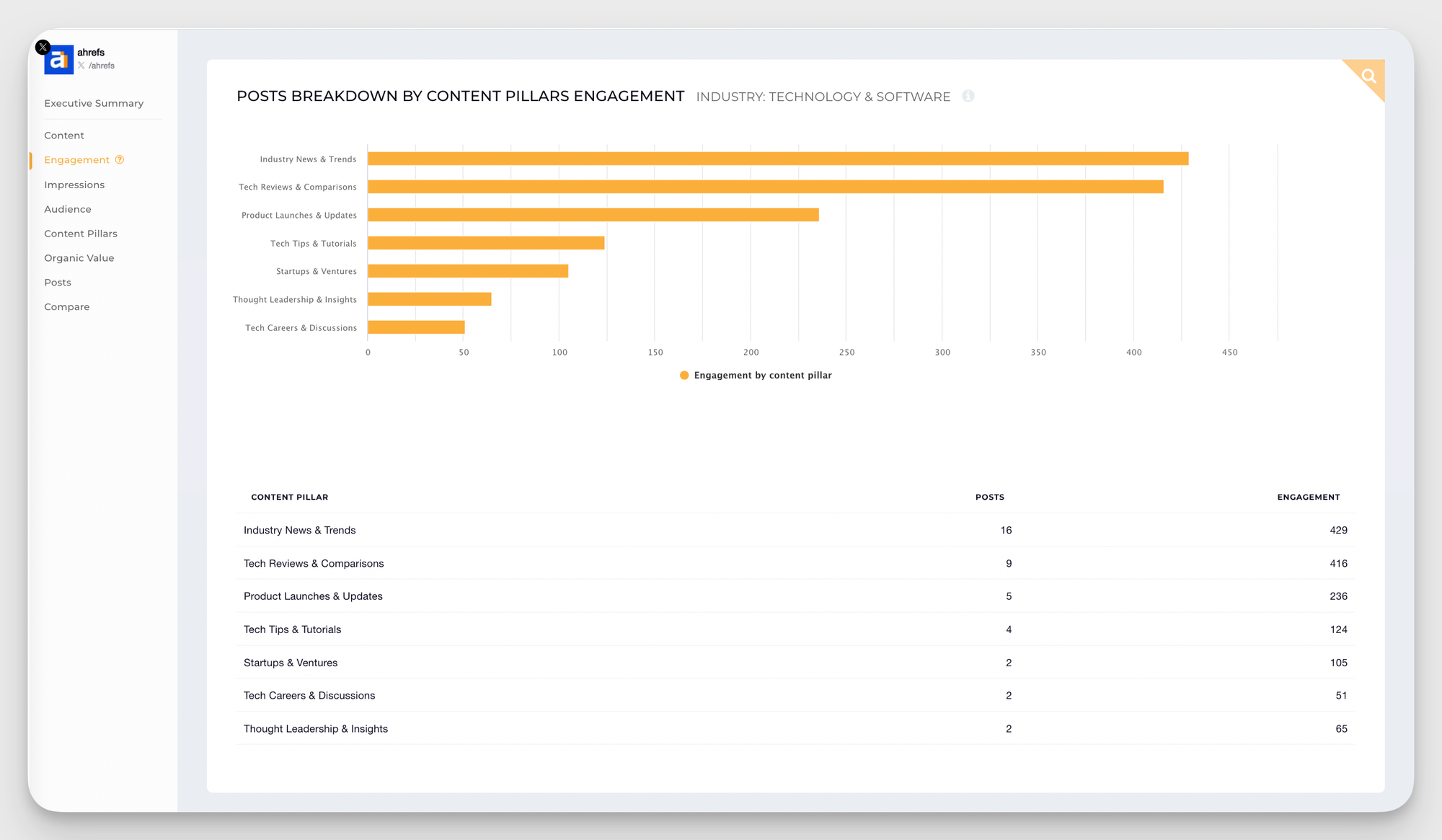
If you have an answer for all of these, then you surely did a great job and you clearly know how to organize your next marketing strategy.
Developing a new strategy after conducting an audit will help you get the sense of a fresh start.
Be bold and adopt new ideas and types of posts that could also inspire others.
To simplify the steps, here's how Kate Meyers Emery, Sr Digital Marketer at Candind does it:
- Always start with making sure the passwords are updated and kept somewhere safe (not a Google doc or post-it, like an actual password software), and review security settings.
- Then, it's looking at each account on every platform to make sure it's visually on brand, all bios are correct, and links work.
- Next, I like to look at the content for the year and see what the top 20 posts were and the bottom 20 for each platform. This gives me an idea of what I should do in the next year, and what I need to replace.
- Then, I'll take a look at broader analytics for the year for each. I want to see whether it's worth investing in this platform moving forward and if my time is worth spending it there.
- Then, I like to take a look at the year from a more holistic perspective. What obstacles did we face, like changing algorithms or political issues? What positive things happened to the brand, like a big launch or new content type, and how did that impact what folks are seeing? By putting the analytics and audit into context, it helps everyone get an understanding of what happened.
- Finally, I'll take a look at what our competitors are up to in a similar way; their top posts, their low performing posts, and their metrics.
And here's what Olga Logunova, social listening and strategy expert adds:
A social media audit starts with analyzing the topics that drive attention. Are there enough of them? Are there unfilled niches? What’s the sentiment — positive or negative — around these topics? Then, I move into audience and performance analysis to see not just how a brand performs in isolation, but in context. Finally, I assess opportunities: what gaps exist that no one is covering, and where can the brand uniquely position itself?
Twitter audit tools to test
To help you get into the nitty-gritty of a Twitter audit, you will most likely need a bit of help digging through all the data.
There is a wide range of social media analytics tools on the market that could help you with your account’s audit.
Here’s a list of the most useful tools you can use to spot bot-generated accounts:
- Socialinsider is an advanced Twitter analytics tool that offers granular data and insightful charts about your Twitter performance which you can use to perform your Twitter audit.
- TwitterAudit takes 5K accounts samples and it’s said to have one of the best accuracy rates to detect bots.
However, tools will only get you so far, especially depending on the budget you have attributed to your Twitter marketing.
It’s up to you to ultimately make sure you set and live up the standards of your account.
Final thoughts
Learning how to perform a social media audit should be one of every marketer’s core skills. This way, they can periodically assess the performance of the brand, leveraging social media analytics to determine when it’s time to change the strategy.
Now that you know how to do a proper Twitter audit, it’s time to conduct the first one.
Remember to save your results and compare them with the following ones.
Frequently Asked Questions about Twitter Audits
1. How often is it recommended to run a Twitter audit?
The frequency of your Twitter audits should depend on how much effort you put into Twitter marketing and the results you're trying to achieve. While the optimal time for running a Twitter audit may be quarterly for some businesses, others may want to look at their Twitter data more frequently, like, for example, monthly.
2. Do you need a tool to perform a Twitter audit?
A Twitter audit can be run manually or by leveraging a third-party tool. It all depends on how in-depth you want to dive into your Twitter analysis and how much time you're willing to invest in it. Usually, an audit platform helps you optimize the task by quickly offering you the information you need and also additional information, depending on each of the app's specificity.
Analyze your competitors in seconds
Track & analyze your competitors and get top social media metrics and more!
You might also like
Improve your social media strategy with Socialinsider!
Use in-depth data to measure your social accounts’ performance, analyze competitors, and gain insights to improve your strategy.



